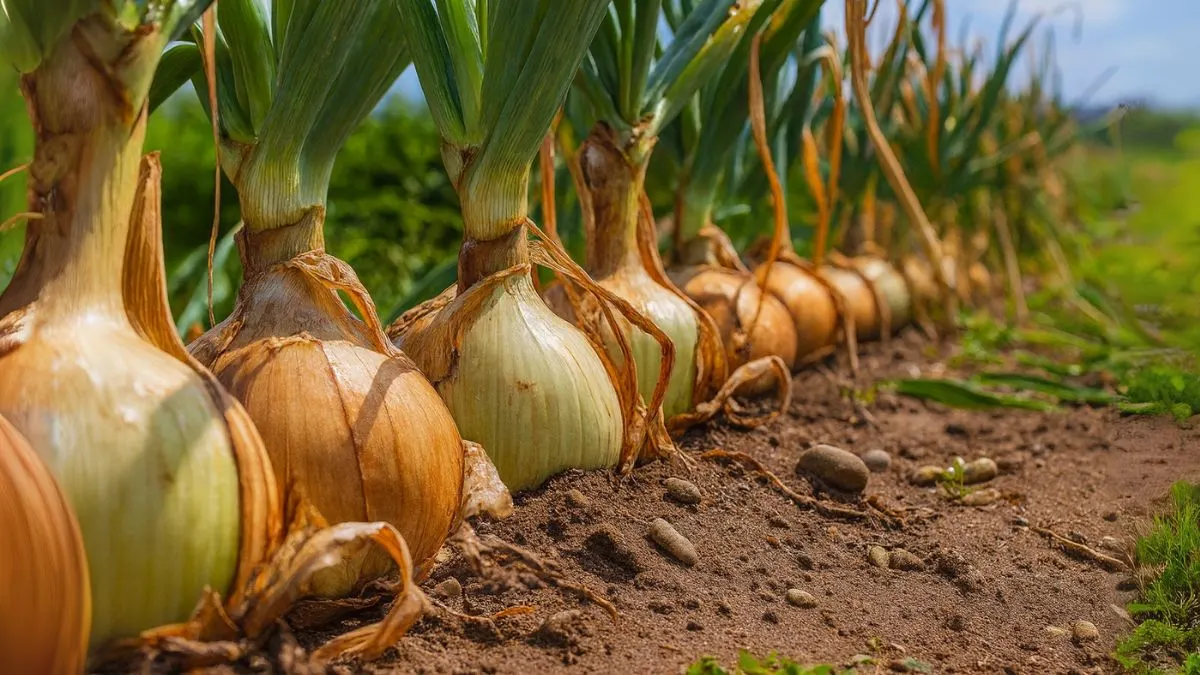Onions are a staple in kitchens worldwide, forming the base of countless recipes. From spicy curries to fresh salads, their flavor is hard to replace. But here’s the good news—you don’t have to rely only on store-bought onions. You can easily grow them in your own backyard, balcony, or even containers.
As a gardener myself, I’ve discovered that onions are among the most rewarding crops. They don’t demand too much attention, but when given the right conditions, they thrive and deliver bountiful harvests.
Why Grow Onions at Home?

- Freshness: Nothing beats pulling out a crisp onion from your own soil.
- Cost-effective: A small packet of seeds gives you dozens of bulbs.
- Control: You know what soil, fertilizers, and pesticides (if any) went into your produce.
- Global popularity: From Canada to the USA and beyond, onions grow well across climates if cared for properly.
Choosing the Right Onion Variety
There are three main types of onions:
- Short-day onions – Best suited for southern regions with mild winters.
- Long-day onions – Thrive in northern climates with long summer days.
- Intermediate-day onions – Adaptable, suitable for a wide range of areas.
Your location matters when deciding which variety to grow. For instance, gardeners in the USA often prefer long-day onions in the north and short-day onions in the south.
Also Read: How to Grow Watermelons for Juicy, Sweet Harvests
Preparing Soil for Onions
The foundation of healthy onions lies in the soil.
- Onions prefer well-drained, fertile soil with a pH between 6.0 and 7.0.
- Add compost or aged manure to enrich the soil.
- Raised beds work particularly well because they improve good drainage.
When I prepared my first onion bed, I underestimated the importance of drainage. A rainy week led to waterlogged soil, and half my bulbs rotted. Lesson learned—abundant sun and good drainage are non-negotiable!
Planting Onions: Seeds, Sets, or Transplants
You can grow onions in three main ways:
1. From Seeds
- Start seeds indoors 8–10 weeks before the last frost.
- Transplant when seedlings are about 6 inches tall.
2. From Sets
- Onion sets (small, immature bulbs) are the easiest method.
- Plant them directly in the soil, 1 inch deep and 4 inches apart.
3. From Transplants
- Purchase young onion plants and transplant them outdoors.
- This option saves time compared to seeds.
Sunlight Requirements
- Onions grow best with abundant sun and good drainage.
- Aim for at least 6–8 hours of direct sunlight daily.
- Partial shade may work, but yields will be smaller.
If you live in a cooler climate, make sure your onions are placed in the sunniest part of your garden.
Watering and Fertilizing
Onions like consistent moisture, but soggy soil is dangerous.
- Water once or twice weekly, depending on rainfall.
- Fertilize with a nitrogen-rich solution every 2–3 weeks.
- Stop fertilizing once bulbs start to swell.
Overwatering is a common mistake—yellow leaves are often a warning sign.
Also Read: How to Plant Mushrooms Indoors
Container Gardening with Onions
No garden? No problem! Onions grow beautifully in containers.
- Choose pots that are at least 8–10 inches deep.
- Fill with well-drained, fertile soil mix.
- Ensure pots have drainage holes to prevent standing water.
I’ve grown onions in balcony planters in Toronto, and they flourished as long as I followed the same rules—sun, soil, and spacing.
Common Problems and Solutions
Problem |
Cause |
Solution |
Small bulbs |
Crowded planting |
Thin seedlings, give more space |
Rotting bulbs |
Poor drainage |
Improve soil, avoid overwatering |
Pests (onion fly, thrips) |
Infestation |
Use neem oil or insecticidal soap |
Yellow leaves |
Nutrient deficiency |
Add compost or nitrogen feed |
Harvesting Onions
Onions are ready to harvest when:
- The tops turn yellow and fall over.
- The bulbs are visible above the soil.
Pull them out gently and let them cure in a dry, airy spot for 2–3 weeks. Properly cured onions last months in storage.
Health Benefits of Onions
Onions are more than a kitchen essential—they’re a health booster:
- Packed with antioxidants.
- Support heart health.
- Anti-inflammatory properties.
- Boost immunity, especially during cold seasons.
Also Read: Why Avocados Are Called Nature’s Butter Fruit
Factor |
Requirement |
Soil |
Well-drained, fertile soil with a pH between 6.0 and 7.0 |
Sunlight |
Abundant sun and good drainage |
Watering |
Moderate, avoid waterlogging |
Planting Options |
Seeds, sets, or transplants |
Harvesting Time |
90–120 days after planting |
Growing onions at home is one of the most rewarding gardening experiences. With well-drained, fertile soil with a pH between 6.0 and 7.0, abundant sun and good drainage, and a little patience, you’ll soon have crisp, flavorful onions ready to harvest. Whether you grow them in garden beds or containers, the results are equally satisfying.
Once you taste the difference of homegrown onions in your dishes, you’ll never look at store-bought ones the same way again.






